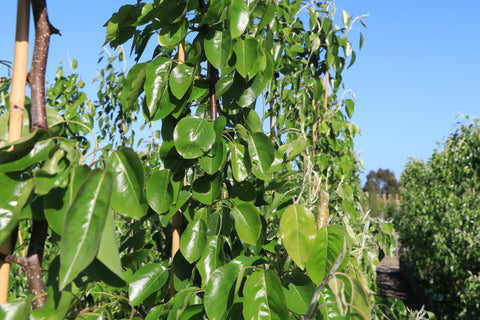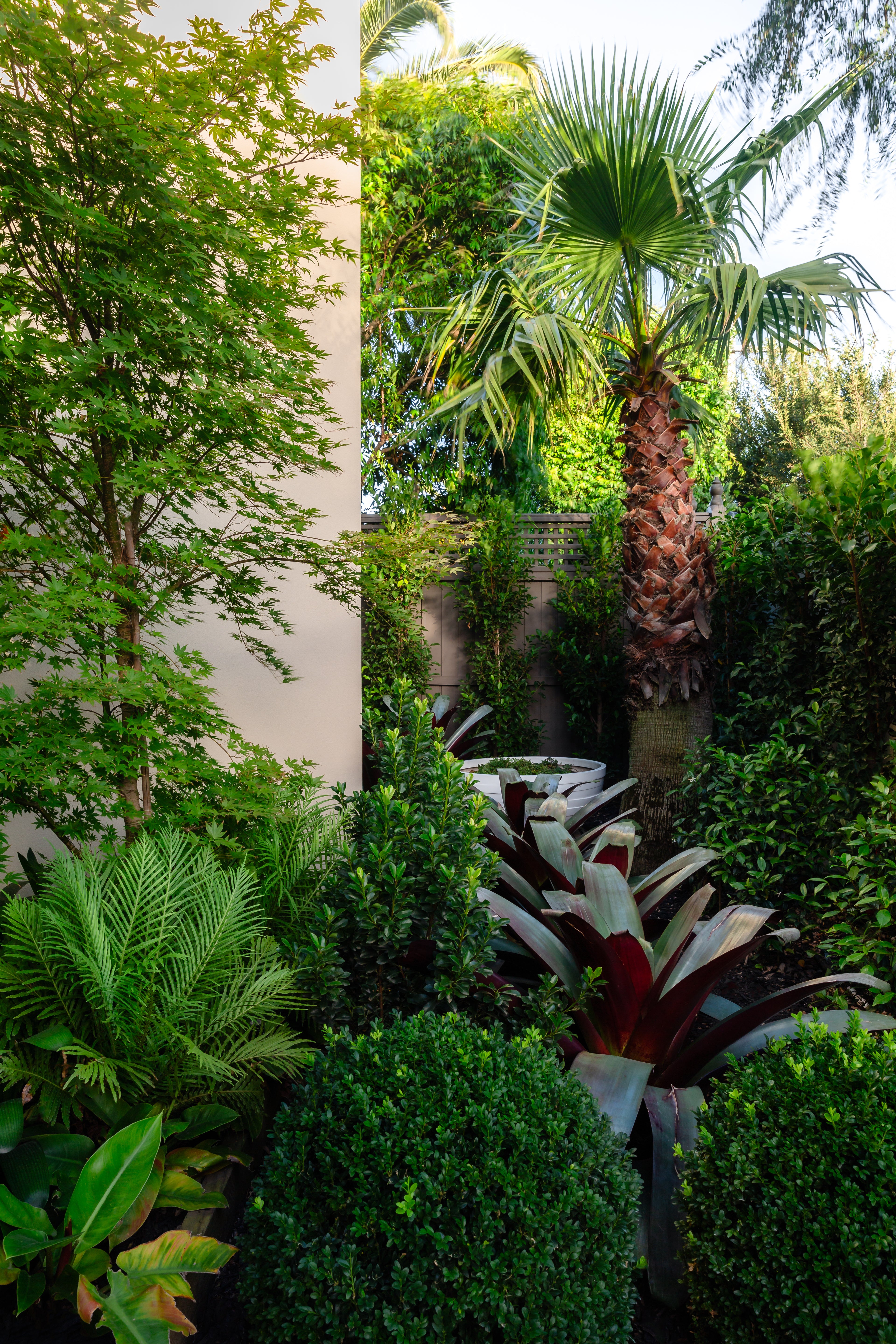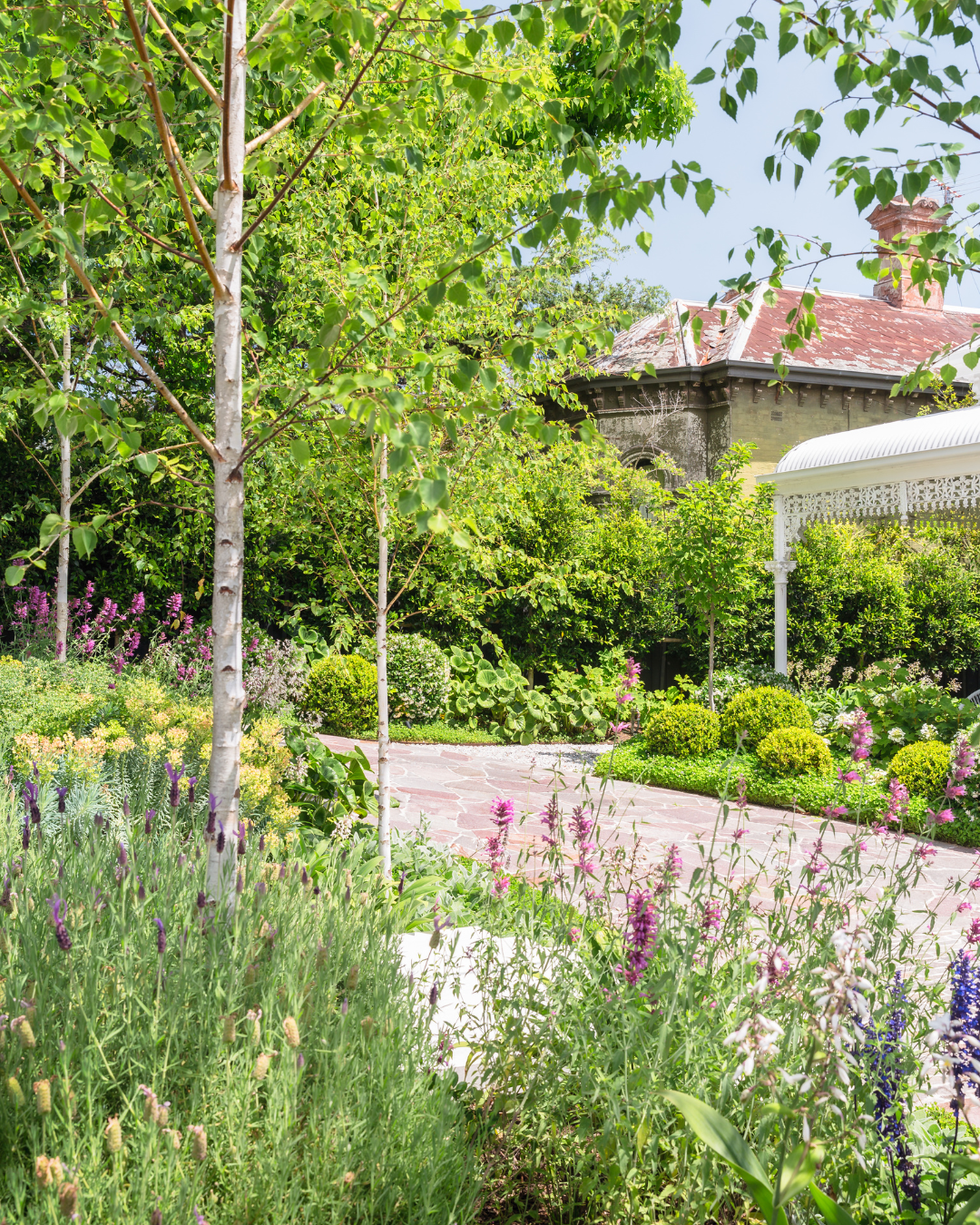Ornamental pear trees are an elegant addition to any garden. With their delicate leaves, green foliage and white flowers in bloom, Ornamental Pear trees add a touch of sophistication and understated beauty to any landscape. Pear Trees are also becoming increasingly popular as street trees, due to their ability to withstand urban conditions.
Characteristics of Ornamental Pear Tree
Growth Rate: Ornamental pears are Fast Growing Deciduous Trees
Watering: Ornamental pears require regular watering until they are established
Pruning: Ornamental pears do not require regular pruning
Sun: Ornamental Pears thrive in full sun or partial shade
Soil: Clay soil, well-draining soil, prefers organic soil but you don't need to worry about the kind of soil that your tree needs. All you need to know is that it needs good drainage. That means that the soil around your tree must drain well so that excess moisture doesn't build up. Moist soil is preferred that drains.
Evergreen or Deciduous: Ornamental Pears are Deciduous Pear Tree Species meaning they lose their leaves in Winter.
Usage: Avenue Trees, Hedging and Screening, Decorative Tree, Excellent Shade tree
Flower: Ornamental Pear trees flower in springtime
Look: Glossy leaves, Blossom in Spring, White spring flowers, Reddish Purple leaves in Autumn, Attractive landscape tree, Shiny dark leaves, come in a variety of shapes and sizes.
Leaf Shapes: Many different shapes and sizes. There are - Oval, Oblong, conical shape, Pyramid Shape, Rounded Shape pear trees and more.
Evergreen Trees Direct Best Sellers: Manchurian Pear Trees, Capital Pears, Cleveland Select or Chanticleer Pear
Planting ornamental pears
When choosing where to plant your ornamental pear tree, consider its mature size when deciding on the right location. You will need to ensure that you have enough space around it. At Evergreen Trees Direct we suggest planting pear trees from between 1m - 2m apart. This way, each tree gets its own area of sunlight and can develop into a healthy specimen.
How to Grow and Care for Ornamental Pear Trees
As we mentioned, Ornamental pears are quite tolerant of urban conditions and are therefore low-maintenance trees. However, they will benefit from a little bit of care and attention. They prefer full sun and well-drained soil, so make sure you choose a spot in your garden that meets these requirements.
Watering
Watering your ornamental pear tree can be tricky. You want to make sure that you are watering enough but not too much. If you water too often, then you run the risk of overwatering the root system. This could cause rot and disease. On the other hand, if you don't water enough, then you may have a problem with dryness. When watering, try to aim at the bottom of the trunk rather than directly at the leaves.
Fertilization
As with all trees, it's important to fertilize your ornamental pear tree regularly. This will help it to grow strong and healthy, and resist pests and diseases. Use a balanced fertilizer such as compost or manure, and apply it around the base of the tree once a year or every two years. There are many different types of fertilizers out there, and they each work differently. Some fertilizers contain micronutrients like iron, zinc, copper, manganese, and magnesium. These elements are needed for healthy plant growth. Other fertilizers contain macro-nutrients like calcium, phosphorous, and potassium. These elements are needed to build strong stems and branches. Contact us if you need assistance.
Mulching
Mulching is a great way to protect your ornamental pear tree from weeds and pests. It also helps retain moisture and keeps the soil cool. When choosing a mulch, look for something that has good drainage properties.
Pruning
Ornamental pear trees don't require much pruning, but you can give them a light trim in late winter or early spring to encourage new growth. Pruning an ornamental pear tree is similar to pruning most other trees. Start by removing dead branches from the top of the tree. Then remove any branches that cross over another branch. Finally, cut back the remaining branches to encourage new growth. Be careful not to damage the main stem of the tree.
Ornamental Pear Tree Pests and Diseases
Ornamental pears are relatively resistant to pests and diseases, but there are a few things you should be on the lookout for. Common problems include aphids, scale insects and caterpillars. These can be controlled with regular applications of an insecticide or fungicide.
Diseases that can affect ornamental pears include fire blight, root rot and leaf spot. These can be treated with a fungicide, but it's always best to Prevention is the best cure, so make sure you choose a healthy tree to plant in your garden.
Ornamental pear tree propagation
Ornamental pear trees can be propagated by seed, but it's much easier (and faster) to grow them from cuttings. Simply take a cutting from a healthy tree in late spring or early summer, and plant it in moist well-drained soil. Keep the cutting moist until it has rooted, then transplant it to its permanent location.
What happens if my ornamental pear gets wind damage?
If your ornamental pear tree has suffered from wind damage, you should get it checked out by a professional arborist. Wind damage can lead to structural issues, which can result in the tree falling down. In some cases, this can even lead to the death of the entire tree.
OUR VARIETIES OF ORNAMENTAL PEARS - EVERGREEN TREES DIRECT
1. Manchurian Pear Tree - BEST SELLER
Manchurian Pears are large trees that are a fast-growing tree and produce lots of fruit. Their bright red fall colors make them a popular choice for landscaping. They also have shiny green leaves in spring and summer. In winter, they turn into beautiful white flowers. Manchurian pear trees are large, broad-spreading trees up to 10 meters tall and 8 meters wide. They grow well in full sun and average soil conditions. Their bright red fall foliage is stunning and their glossy green spring foliage is also beautiful. In early spring, they produce small white flowers.

Click here to view our Manchurian Pear Trees
2. Capital Pear Trees
Capital Pears is a rounded shaped, oval, or oblong-shaped ornamental tree. They have white flowers in spring that turn into small hard fruit. Capital pears are great for hedges and screening because of their dense growth habit. Capital Pears are the narrowest-growing of all the ornamental Pear Trees. They look great used to frame entrances, multi-planted into a mini-tree forest, or used as an attractive vertical screen. They grow slowly developing a small bare trunk at ground level which can be used as an interesting feature or planted below to create a dense leaf-filled look in the garden. Capital Pears also have an attractive curl in the foliage that adds further interest and the slender, columnar shape lends itself well to tight spaces.

Click here to view our 45L Capital Pear Tree
Click here to view our 200L Capital Pear Tree
3. Cleveland Select Tree/ Chanticleer Pear Ornamental Tree
The Cleveland Select or Pyrus Chanticleer Pear variety is one of the most popular ornamental pear trees. They are a medium tree of the pear variety that has beautiful green foliage and white blossoms in spring, bright red Autumn colour, and beautiful dark green summer foliage. Cleveland Selects or Pyrus Chanticleer Pear are deciduous trees, so they lose their leaves in winter. The Cleveland Select variety grows to be about 30 feet tall and 20 feet wide. It has a spreading, semi-upright growth habit, making it ideal for use as a hedge, screen, or avenue plant. This variety is easy to care for and requires little maintenance. The leaves are glossy and waxy, making them resistant to insects and disease. The fruits are generally 1 inch long and weigh less than 2 ounces. They ripen from late October through December.

Click here to view our Cleveland Select Pear Trees 200L
Click here to view our Cleveland Select Pear Trees 300L
4. Bradford Pear/ Pyrus Calleryana
Bradford Pear or Pyrus Calleryana is another popular ornamental pear tree. These are deciduous trees with a slow growing habit. They have a round head with a flat top. They have a very attractive reddish color in autumn and a yellowish color in spring. They have a smooth bark that peels off easily. They have a sweet fragrance when crushed. They have a strongroot system and do not need staking. They are easy to grow and require little water. Theyare best grown in a sunny position but will tolerate light shade. They are good choices for planting along walkways, patios, and borders.
Click here to view our PYRUS CALLERYANA 'CAPITAL' 45L
Non-Fruit Bearing/ Fruitless Pear Trees
There are many varieties of pears that do not produce fruits. Ornamental pear trees include 'Bartlett' and 'Doyenne du Comice'. These trees are very popular because they are easy to grow and maintain. They also provide beautiful spring blooms and autumn foliage. Non-fruit bearing pear tree varieties are the perfect tree to be used as a shade tree, a street tree, or even as a feature tree.
Ornamental pear trees are lovely additions to any garden, and with a little bit of care they will thrive for many years. We hope this article has given you everything you need to know about these beautiful trees.
Contact us for any of your other Ornamental Pear Questions
Happy gardening!











6 comments
I have a 30ish year old callery pear tree in the front yard. It grew, then dropped thousands to balls on a stem like a cherry cluster but the size of a garbanzo bean. Whey did this happen this year. Also, is it to late to lightly fertilize? It’s at the leafing stage.
I have a 12 year old hedge of ornamental trees that we had pruned a couple of years ago. Since then the foliage has thinned lower down on the trunk so much that they now longer act as an effective screen. Growth is concentrated at the top. I am unsure what to do.
I have these young seedless pear trees in our panhandle of Texas yard. I have staked around the trees to help support until stronger. How long before these trees can be independent and not so much need help in their support for growth
We have y Chanticleer trees which we planted in 2019. One looks very sick, very pale green leaves, lack of leaves especially in the central region of the tree. I am unsure what is wrong?
Great blog! So much useful information here. I need to check with my tree removal company what are my next steps and how they can help me. I realized I have a problem by reading this. Thanks!